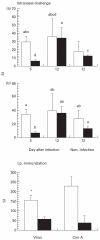Fish oil feeding enhances lymphocyte proliferation but impairs virus-specific T lymphocyte cytotoxicity in mice following challenge with influenza virus
- PMID: 10632664
- PMCID: PMC1905511
- DOI: 10.1046/j.1365-2249.2000.01135.x
Fish oil feeding enhances lymphocyte proliferation but impairs virus-specific T lymphocyte cytotoxicity in mice following challenge with influenza virus
Abstract
The effect of a fish oil diet on virus-specific cytotoxicity and lymphocyte proliferation was investigated. Mice were fed fish oil (17 g fish oil and 3 g sunflower/100 g) or beef tallow (17 g tallow and 3 g sunflower/100 g) diets for 14 days before intranasal challenge with influenza virus. At day 5 after infection, lung virus-specific T lymphocyte, but not macrophage or natural killer (NK) cell, cytotoxicity was significantly lower in mice fed fish oil, while bronchial lymph node cell proliferation to virus was significantly higher. In mice fed fish oil, spleen cell proliferation to virus was also significantly higher following immunization. The results showed that, despite improved lymphocyte proliferation, fish oil impairs primary virus-specific T lymphocyte cytotoxicity. This impairment may explain the delayed virus clearance that we have previously reported in infected mice fed the fish oil diet.
Figures


Similar articles
-
Fish oil feeding delays influenza virus clearance and impairs production of interferon-gamma and virus-specific immunoglobulin A in the lungs of mice.J Nutr. 1999 Feb;129(2):328-35. doi: 10.1093/jn/129.2.328. J Nutr. 1999. PMID: 10024609
-
Fish oil-fed mice have impaired resistance to influenza infection.J Nutr. 2009 Aug;139(8):1588-94. doi: 10.3945/jn.109.108027. Epub 2009 Jun 23. J Nutr. 2009. PMID: 19549756 Free PMC article.
-
Influenza in senescent mice: impaired cytotoxic T-lymphocyte activity is correlated with prolonged infection.Immunology. 1991 Apr;72(4):514-9. Immunology. 1991. PMID: 2037313 Free PMC article.
-
Dietary fats affect macrophage-mediated cytotoxicity towards tumour cells.Immunol Cell Biol. 2000 Feb;78(1):40-8. doi: 10.1046/j.1440-1711.2000.00867.x. Immunol Cell Biol. 2000. PMID: 10651928
-
Fatty acids, dietary lipids and lymphocyte functions.Biochem Soc Trans. 1995 May;23(2):302-9. doi: 10.1042/bst0230302. Biochem Soc Trans. 1995. PMID: 7672330 Review. No abstract available.
Cited by
-
Biological and clinical significance of lipids as modulators of immune system functions.Clin Diagn Lab Immunol. 2002 Sep;9(5):945-50. doi: 10.1128/cdli.9.5.945-950.2002. Clin Diagn Lab Immunol. 2002. PMID: 12204942 Free PMC article. Review. No abstract available.
-
Relevance of dietary lipids as modulators of immune functions in cells infected with Listeria monocytogenes.Clin Diagn Lab Immunol. 2002 Mar;9(2):352-7. doi: 10.1128/cdli.9.2.352-357.2002. Clin Diagn Lab Immunol. 2002. PMID: 11874877 Free PMC article.
-
COVID-19: The Inflammation Link and the Role of Nutrition in Potential Mitigation.Nutrients. 2020 May 19;12(5):1466. doi: 10.3390/nu12051466. Nutrients. 2020. PMID: 32438620 Free PMC article. Review.
-
Potential benefits and risks of omega-3 fatty acids supplementation to patients with COVID-19.Free Radic Biol Med. 2020 Aug 20;156:190-199. doi: 10.1016/j.freeradbiomed.2020.07.005. Epub 2020 Jul 10. Free Radic Biol Med. 2020. PMID: 32653511 Free PMC article. Review.
-
Can N-3 polyunsaturated fatty acids be considered a potential adjuvant therapy for COVID-19-associated cardiovascular complications?Pharmacol Ther. 2021 Mar;219:107703. doi: 10.1016/j.pharmthera.2020.107703. Epub 2020 Oct 5. Pharmacol Ther. 2021. PMID: 33031856 Free PMC article. Review.
References
-
- Kremer JM, Lawrence DA, Jubiz W, et al. Dietary fish oil and olive oil supplementation in patients with rheumatoid arthritis. Arthritis Rheum. 1990;33:810–20. - PubMed
-
- Stenson WF, Cort D, Rodgers J, et al. Dietary supplementation with fish oil in ulcerative colitis. Ann Intern Med. 1992;116:609–14. - PubMed
-
- Dyerberg J, Bang HO, Stofferson E, Moncada S, Vane JR. Eicosapentaenoic acid and prevention of thrombosis and atherosclerosis? Lancet. 1978;2:117–9. - PubMed
-
- Wigmore SJ, Fearon KC, Maingay JP, Ross JA. Down-regulation of the acute-phase response in patients with pancreatic cancer cachexia receiving oral eicosapentaenoic acid is mediated via suppression of interleukin-6. Clin Sci. 1997;92:215–21. - PubMed
MeSH terms
Substances
LinkOut - more resources
Full Text Sources

